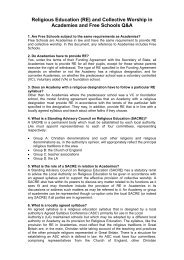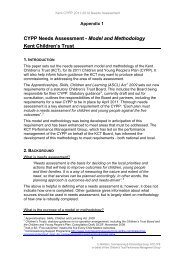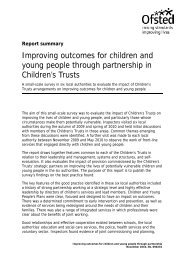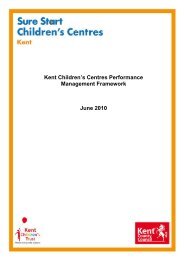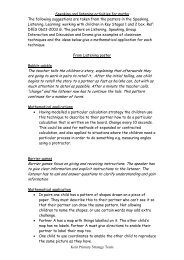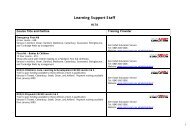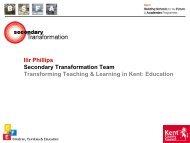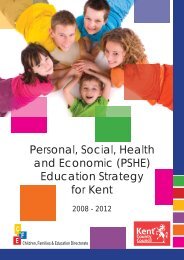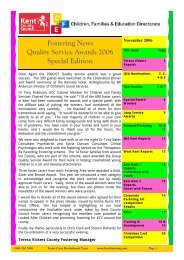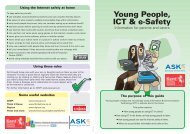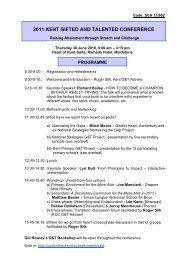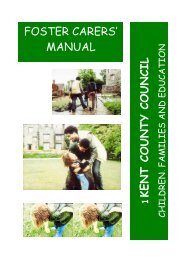Key Stage 1 - Kent Trust Web
Key Stage 1 - Kent Trust Web
Key Stage 1 - Kent Trust Web
Create successful ePaper yourself
Turn your PDF publications into a flip-book with our unique Google optimized e-Paper software.
Science:<br />
Attainment target 1: Scientific enquiry:<br />
Level 2<br />
Pupils respond to suggestions about how to find things out and, with help, make their own suggestions<br />
about how to collect data to answer questions. They use simple texts, with help, to find information. They<br />
use simple equipment provided and make observations related to their task. They observe and compare<br />
objects, living things and events. They describe their observations using scientific vocabulary and record<br />
them, using simple tables when appropriate. They say whether what happened was what they expected.<br />
Level 3<br />
Pupils respond to suggestions and put forward their own ideas about how to find the answer to a<br />
question. They recognise why it is important to collect data to answer questions. They use simple texts<br />
to find information. They make relevant observations and measure quantities, such as length or mass,<br />
using a range of simple equipment. Where appropriate, they carry out a fair test with some help,<br />
recognising and explaining why it is fair. They record their observations in a variety of ways. They<br />
provide explanations for observations and for simple patterns in recorded measurements. They<br />
communicate in a scientific way what they have found out and suggest improvements in their work.<br />
Level 4<br />
Pupils recognise that scientific ideas are based on evidence. In their own investigative work, they decide<br />
on an appropriate approach [for example, using a fair test] to answer a question. Where appropriate,<br />
they describe, or show in the way they perform their task, how to vary one factor while keeping others<br />
the same. Where appropriate, they make predictions. They select information from sources provided for<br />
them. They select suitable equipment and make a series of observations and measurements that are<br />
adequate for the task. They record their observations, comparisons and measurements using tables and<br />
bar charts. They begin to plot points to form simple graphs, and use these graphs to point out and<br />
interpret patterns in their data. They begin to relate their conclusions to these patterns and to scientific<br />
knowledge and understanding, and to communicate them with appropriate scientific language. They<br />
suggest improvements in their work, giving reasons.<br />
Level 5<br />
Pupils describe how experimental evidence and creative thinking have been combined to provide a<br />
scientific explanation [for example, Jenner's work on vaccination at <strong>Key</strong> <strong>Stage</strong> 2, Lavoisier's work on<br />
burning at <strong>Key</strong> <strong>Stage</strong> 3]. When they try to answer a scientific question, they identify an appropriate<br />
approach. They select from a range of sources of information. When the investigation involves a fair test,<br />
they identify key factors to be considered. Where appropriate, they make predictions based on their<br />
scientific knowledge and understanding. They select apparatus for a range of tasks and plan to use it<br />
effectively. They make a series of observations, comparisons or measurements with precision<br />
appropriate to the task. They begin to repeat observations and measurements and to offer simple<br />
explanations for any differences they encounter. They record observations and measurements<br />
systematically and, where appropriate, present data as line graphs. They draw conclusions that are<br />
consistent with the evidence and begin to relate these to scientific knowledge and understanding. They<br />
make practical suggestions about how their working methods could be improved. They use appropriate<br />
scientific language and conventions to communicate quantitative and qualitative data.<br />
37



